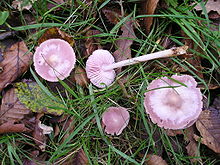- Mycena pura
-
Mycena pura 
Scientific classification Kingdom: Fungi Division: Basidiomycota Class: Basidiomycetes Order: Agaricales Family: Mycenaceae Genus: Mycena Species: M. pura Binomial name Mycena pura
(Pers.) P. Kumm.Mycena pura Mycological characteristics 
gills on hymenium 
cap is conical 
hymenium is adnate 
stipe is bare 
spore print is white 
ecology is saprotrophic 
edibility: unknown Mycena pura, commonly known as the lilac bonnet,[1] is a species of mushroom in the Mycenaceae family. First called Agaricus prunus in 1794 by Christian Hendrik Persoon, it was assigned its current name in 1871 by German Paul Kummer.[2] Mycena pura is known to bioaccumulate the element boron.[3]
Bioactive compounds
Mycena pura contains the chemical puraquinonic acid, a sesquiterpene. This compound induces mammalian cells (specifically, the cell line HL60) to differentiate into granulocyte- or macrophage-like cells. The fungus also contains the antifungal metabolite strobilurin D, previously found in Cyphellopsis anomala.[4]
External links
References
- ^ "Recommended English Names for Fungi in the UK" (PDF). British Mycological Society. http://www.britmycolsoc.org.uk/resources.asp?Cat=Recommended%20English%20Names%20for%20Fungi%20in%20the%20UK%20%20. Retrieved 2009-09-11.[dead link]
- ^ Kummer P. (1871). Der Führer in die Pilzkunde. Zerbst. p. 107.
- ^ Vetter Y. (1995). "Boron content of edible mushrooms of Hungary". Zeitschrift fur Lebensmittel-Untersuchung und Forschung 201 (6): 524–27.
- ^ Becker U, Erkel G, Anke T, Sterner O., U.; Erkel, G.; Anke, T.; Sterner, O. (1997). "Puraquinonic acid, a novel inducer of differentiation of human HL-60 promyelocytic leukemia cells from Mycena pura (Pers. Ex Fr.)". Natural Product Research 9 (3): 229–36. doi:10.1080/10575639708048319.
Categories:- Mycena
- Fungi of Europe
Wikimedia Foundation. 2010.
